Read the following extract and answer the questions given below:
Chronic floods during the monsoon, on an average, affect more than 30 million Indians annually. Ironically, 60% of India's farmland, 66%% of its livestock and its entire forest area depends on rains for survival.
According to a recently released Central Water
Commission (CWC) report, on an average, 7·21 million hectares (roughly 72,000 sq. km.) go under floodwater. This water typically ravages 3·78 million hectares of agricultural land, damaging crops worth f 1,118 crore, annually.
Heavy rains and floods account for nearly 1,700 lives lost annually. Apart from this, 1 ·25 lakh houses are annually damaged by torrential rains that also wipe out nearly 96,000 livestock.
Floods are the most recurrent natural calamity, hitting India almost every year. According to the CWC's report on financial aspects of flood control, anti-sea erosion and drainage projects, it is not possible to provide absolute protection instantly to all flood-prone areas. It says that such an attempt will neither be practical nor economically viable.
Give the meanings of :
(i) entire
(ii) calamity
(i) whole/ complete
(ii) disaster.
Topper's Solved these Questions
- BOOK - GURUKUL PUBLICATION - MAHARASHTRA PREVIOUS YEAR PAPERSCHAPTER - FEBRUARY 2016EXERCISE - SECTION-B8videos
FEBRUARY 2016
- BOOK - GURUKUL PUBLICATION - MAHARASHTRA PREVIOUS YEAR PAPERSCHAPTER - FEBRUARY 2016EXERCISE - SECTION - C3videos
FEBRUARY 2016
- BOOK - GURUKUL PUBLICATION - MAHARASHTRA PREVIOUS YEAR PAPERSCHAPTER - FEBRUARY 2015EXERCISE - SECTION - D (WRITTEN COMMUNICATION)8videos
FEBRUARY 2015
- BOOK - GURUKUL PUBLICATION - MAHARASHTRA PREVIOUS YEAR PAPERSCHAPTER - FEBRUARY 2017EXERCISE - SET D SECTION -C (Rapid Reading and Composition )3videos
FEBRUARY 2017
Similar Questions
Read the following extract and answer the questions given below:
Chronic floods during the monsoon, on an average, affect more than 30 million Indians annually. Ironically, 60% of India's farmland, 66%% of its livestock and its entire forest area depends on rains for survival.
According to a recently released Central Water Commission (CWC) report, on an average, 7·21 million hectares (roughly 72,000 sq. km.) go under floodwater. This water typically ravages 3·78 million hectares of agricultural land, damaging crops worth f 1,118 crore, annually.
Heavy rains and floods account for nearly 1,700 lives lost annually. Apart from this, 1 ·25 lakh houses are annually damaged by torrential rains that also wipe out nearly 96,000 livestock.
Floods are the most recurrent natural calamity, hitting India almost every year. According to the CWC's report on financial aspects of flood control, anti-sea erosion and drainage projects, it is not possible to provide absolute protection instantly to all flood-prone areas. It says that such an attempt will neither be practical nor economically viable.
What is the above extract about ?View SolutionRead the following extract and answer the questions given below:
Chronic floods during the monsoon, on an average, affect more than 30 million Indians annually. Ironically, 60% of India's farmland, 66%% of its livestock and its entire forest area depends on rains for survival.
According to a recently released Central Water Commission (CWC) report, on an average, 7·21 million hectares (roughly 72,000 sq. km.) go under floodwater. This water typically ravages 3·78 million hectares of agricultural land, damaging crops worth f 1,118 crore, annually.
Heavy rains and floods account for nearly 1,700 lives lost annually. Apart from this, 1 ·25 lakh houses are annually damaged by torrential rains that also wipe out nearly 96,000 livestock.
Floods are the most recurrent natural calamity, hitting India almost every year. According to the CWC's report on financial aspects of flood control, anti-sea erosion and drainage projects, it is not possible to provide absolute protection instantly to all flood-prone areas. It says that such an attempt will neither be practical nor economically viable.
How do floods adversely affect India ?View Solution
Knowledge Check
- Question 1 - Select One
Read the following graph and answer the questions given below
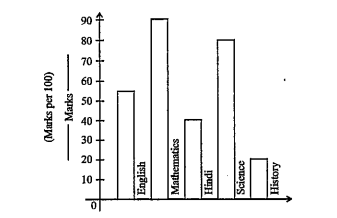
average marks obtained by the student isA57B63C80D48 - Question 2 - Select One
Study the following graph and answer the questions given below -----
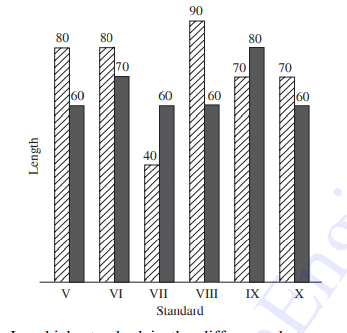
In which standard is the result of boys less than the average result of the girls ?AVIIBIXCVIDVIII - Question 3 - Select One
Study the following graph and answer the questions given below -----
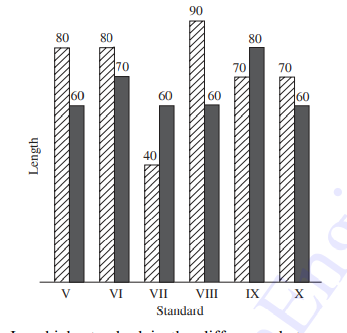
In which standard is the result of the girls more than the average result of the boys for the school ?AIXBVIIICVIDX
Read the following extract and answer the questions given below:
Chronic floods during the monsoon, on an average, affect more than 30 million Indians annually. Ironically, 60% of India's farmland, 66%% of its livestock and its entire forest area depends on rains for survival.
According to a recently released Central Water Commission (CWC) report, on an average, 7·21 million hectares (roughly 72,000 sq. km.) go under floodwater. This water typically ravages 3·78 million hectares of agricultural land, damaging crops worth f 1,118 crore, annually.
Heavy rains and floods account for nearly 1,700 lives lost annually. Apart from this, 1 ·25 lakh houses are annually damaged by torrential rains that also wipe out nearly 96,000 livestock.
Floods are the most recurrent natural calamity, hitting India almost every year. According to the CWC's report on financial aspects of flood control, anti-sea erosion and drainage projects, it is not possible to provide absolute protection instantly to all flood-prone areas. It says that such an attempt will neither be practical nor economically viable.
How would you help the flood-affected people ?View SolutionRead the following extract and answer the questions given below:
Chronic floods during the monsoon, on an average, affect more than 30 million Indians annually. Ironically, 60% of India's farmland, 66%% of its livestock and its entire forest area depends on rains for survival.
According to a recently released Central Water Commission (CWC) report, on an average, 7·21 million hectares (roughly 72,000 sq. km.) go under floodwater. This water typically ravages 3·78 million hectares of agricultural land, damaging crops worth f 1,118 crore, annually.
Heavy rains and floods account for nearly 1,700 lives lost annually. Apart from this, 1 ·25 lakh houses are annually damaged by torrential rains that also wipe out nearly 96,000 livestock.
Floods are the most recurrent natural calamity, hitting India almost every year. According to the CWC's report on financial aspects of flood control, anti-sea erosion and drainage projects, it is not possible to provide absolute protection instantly to all flood-prone areas. It says that such an attempt will neither be practical nor economically viable.
Rewrite the following sentences in the ways instructed.
(i) The floods of 1978 were the most destructive.
(ii) Floods are the most recurrent natural calamity hitting India almost every year.
( Make it a complex sentence.)
(iii) Floods have been far more destructive.
(Rewrite the sentence using the Simple Present tense.)View SolutionRead the following extract and answer the questions given below:
Chronic floods during the monsoon, on an average, affect more than 30 million Indians annually. Ironically, 60% of India's farmland, 66%% of its livestock and its entire forest area depends on rains for survival.
According to a recently released Central Water Commission (CWC) report, on an average, 7·21 million hectares (roughly 72,000 sq. km.) go under floodwater. This water typically ravages 3·78 million hectares of agricultural land, damaging crops worth f 1,118 crore, annually.
Heavy rains and floods account for nearly 1,700 lives lost annually. Apart from this, 1 ·25 lakh houses are annually damaged by torrential rains that also wipe out nearly 96,000 livestock.
Floods are the most recurrent natural calamity, hitting India almost every year. According to the CWC's report on financial aspects of flood control, anti-sea erosion and drainage projects, it is not possible to provide absolute protection instantly to all flood-prone areas. It says that such an attempt will neither be practical nor economically viable.
Why is it not possible to provide absolute protection to all flood-prone areas ?View SolutionRead the following graph carefully and answer the questions given below:
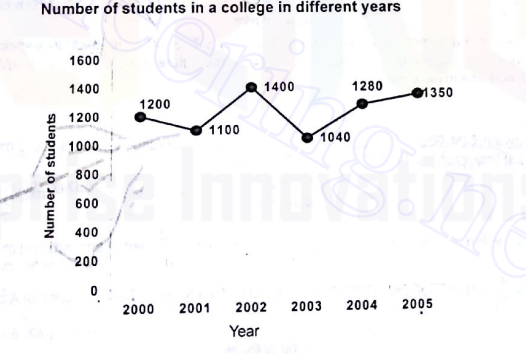
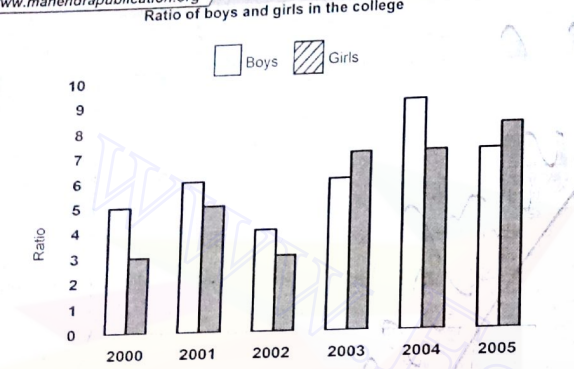
What is the average number of girls in all the years?View SolutionRead the following graph carefully and answer the questions given below.
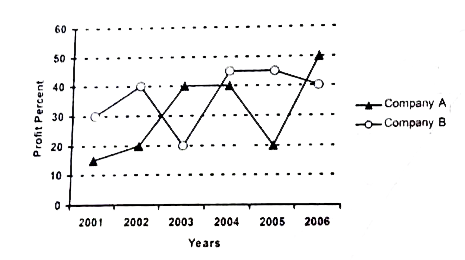
In which year the average of the profit percent of the both companies was the maximum ?View Solution

